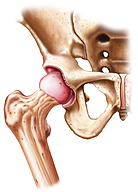Digital Stability Test for Total Hip Arthroplasty: New Concept for Next Generation of Computer Assisted Surgery
TECHNOLOGY NUMBER: 7782

OVERVIEW
A digital stability test that assesses implant placement during orthopedic surgeries- More cost-effective and accurate than existing manual stability tests
- Reduced human error with minimal training requirements for assessment of hip arthroplasty
BACKGROUND
Dislocation is one of the most important complications after total hip arthroplasty (THA) and occurs in 1-5% of THA patients, some of which will require revision surgery. Even if treated non-operatively, the patients who sustain postoperative dislocations have lower satisfaction rates and worse functional outcomes. Implant alignment is the most important factor that causes dislocation and can be modified by orthopedic surgeons. In order to improve the alignment of the implants, the surgeons can use either insertion guides (conventional method) or computer-assisted navigation systems. The surgeons will conduct a stability test in the operation room regardless of the method used for the implantation. Currently, this stability test is performed manually without any digital guidance. Surgeons generally have to place their finger around the trial femoral head to see if it dislocates during the test or not. This increases the possibility of contamination and, as a result, infection and is very inaccurate.
INNOVATION
Researchers have designed a digital stability test device that can be used with any of the currently available implants used for total hip arthroplasty. The innovators describe a method that more accurately describes the hip-spine relationship and which requires minimal training to implement. This approach reduces human error that is associated with existing approaches for implant assessment. The advantages to the digital stability test include a decrease in post-surgical infection rates and a more cost-effective test than other navigation systems for computer-assisted surgery. The technology therefore heralds an improvement in stability testing of medical implants.
PATENT APPLICATION
Number: PCT/US2019/025051